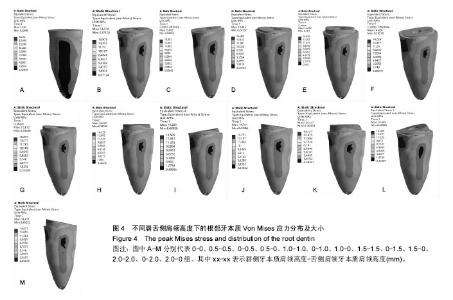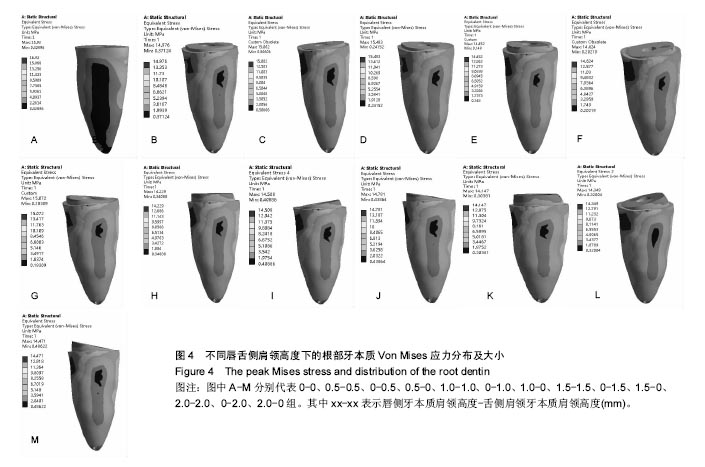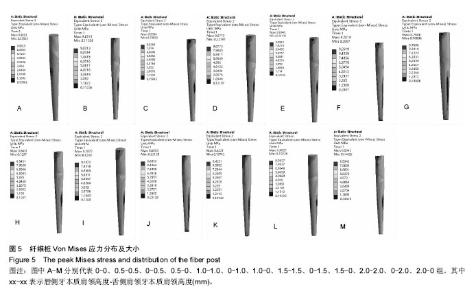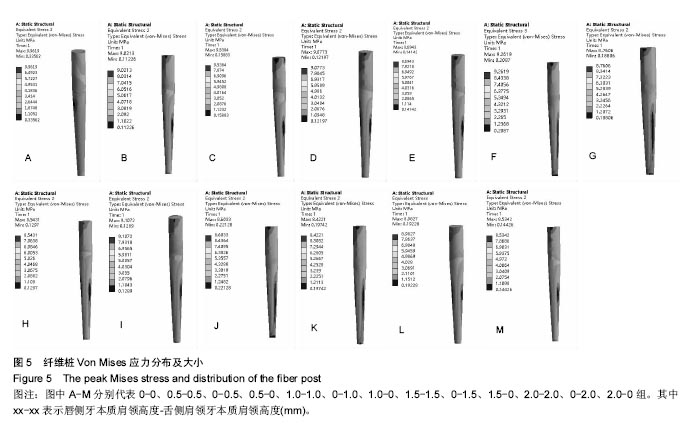| [1]常志明.玻璃纤维桩与金属桩核修复牙体缺损的比较[J].中国组织工程研究,2013,17(29):5309-5315.[2]张一祎.桩核修复体肩领效应的扩展有限元分析&病例报告[D].武汉大学,2015.[3]赵铱民.口腔修复学[M].7版.北京:人民卫生出版社,2012.[4]康成容,魏素华,周折冲,等.牙本质肩领高度对上颌中切牙应力影响的三维有限元研究[J].口腔颌面修复学杂志,2016,17(1):31-36.[5]王惠芸.我国人牙的测量和统计[J].中华口腔科杂志, 1959,7(3): 149-155. [6]詹文辉.Flexi-Flange纤维桩修复上颌中切牙的三维有限元研究[D].南昌大学,2015.[7]康成容,潘宣,李梁,等.纤维桩核冠修复上颌中切牙三维有限元模型的建立[J].中国组织工程研究,2012,16(4):660-664.[8]杰恩斯,史力,刘鹏,等.纤维桩核修复3种上切牙牙冠缺损类型的有限元应力对比[J].中国组织工程研究与临床康复, 2009, 13(17):3251-3255.[9]Santos-Filho PC,Verissimo C,Soares PV,et al.Influence of ferrule, post system, and length on biomechanical behavior of endodontically treated anterior teeth.J Endod.2014;40(1): 119-123.[10]Dejak B,Mlotkowski A.The influence of ferrule effect and length of cast and FRC posts on the stresses in anterior teeth.Dent Mater.2013;29(9):e227-e237.[11]Tan PL,Aquilino SA,Gratton DG,et al.In vitro fracture resistance of endodontically treated central incisors with varying ferrule heights and configurations.J Prosthet Dent. 2005;93(4):331-336.[12]Liu T,Geng H,Rong Q,et al.Three-dimensional finite element analysis on half of the structure defect with post core and all-ceramic crown restoration of mandibular first molar.Zhonghua Kou Qiang Yi Xue Za Zhi. 2015;50(9):561-564. [13]Abduo J.Influence of fixed prosthodontic treatment on occlusal contacts in centric occlusion: a preliminary study.Br J Med Med Res.2015;5(12):1580-1589.[14]Croci CS,Caria PHF,Croci CS,et al.Rotation axis of the maxillary molar and maximum tooth movement according to force direction.Braz J Oral Sci.2015;14(2):130-134.[15]Abuelenain DA,Ajaj R,El-Bab EI,et al.Comparison of Stresses Generated within the Supporting Structures of Mandibular Second Molars Restored with Different Crown Materials: 3-D Finite Element Analysis (FEA).J Prosthodont. 2014;24(6): 484-493. [16]Chiba A,Hatayama T,Kainose K,et al.The influence of elastic moduli of core materials on shear stress distributions at the adhesive interface in resin built-up teeth.Dent Mater J. 2017;36(1):95-102.[17]张凌凌.纤维桩在前牙美学修复中的应用及三维有限元应力分析[D].天津医科大学,2008. [18]王旭.修复上颌中切牙残根的桩核冠技术参数的有限元分析研究[D].河北科技大学,2015.[19]王文亚,傅波,罗华,等.不同桩核冠修复上颌中切牙的三维有限元模型建立及应力分析[J].医用生物力学,2014,29(1):25-30.[20]Wang MQ,Zhang M,Zhang JH.Photoelastic study of the effects of occlusal surface morphology on tooth apical stress from vertical bite forces.J Contemp Dent Pract. 2004;5(1): 74-93.[21]Benazzi S,Kullmer O,Grosse IR,et al.Using occlusal wear information and finite element analysis to investigate stress distributions in human molars.J Anat.2011;219(3):259-272.[22]张帼,韩祥永,陈小平.三种纤维桩系统修复上颌中切牙的三维有限元研究[J].中国美容医学,2016,25(5):47-49.[23]孙晰.纤维桩对上颌中切牙牙根应力分布影响的三维有限元分析[D].南方医科大学,2007.[24]董少杰,兰亭,孔婷婷,等.纯钛桩核及纤维桩核冠修复上颌中切牙薄壁残根后的有限元应力分析[J].西安交通大学学报(医学版), 2017,38(2):299-303.[25]廖沐莹.不同临床冠根比的上颌中切牙三维有限元分析[D].福建医科大学,2012.[26]山雯婷,俞灏,顾晓宇,等.唇、腭向倾斜上中切牙桩核冠修复有限元模型的构建[J].口腔颌面修复学杂志,2013,15(5):281-285.[27]Santos- Filho PC,Verissimo C,Soares PV,et al.Influence of ferrule, post system, and length on biomechanical behavior of endodontically treated anterior teeth.J Endod. 2014;40(1): 119-123.[28]Okada D,Miura H,Suzuki C,et al.Stress Distribution in Roots Restored with Different Types of Post Systems with Composite Resin.Dent Mater J.2008;27(4):605-611.[29]Durmu? G,Oyar P.Effects of post core materials on stress distribution in the restoration of mandibular second premolars: A finite element analysis.J Prosthet Dent.2014;112(3): 547-554.[30]Da Silva FM,Septímio Lanza MD,Landre Júnior J,et al. Influence of Increase of the Occlusal Contact Area on the Tension Generation on Natural Teeth and Adjacent Structures by Finite Element Analysis(FEA).Dentistry.2014;4:244.[31]Yi YJ,Kelly JR.Effect of occlusal contact size on interfacial stresses and failure of a bonded ceramic: FEA and monotonic loading analyses.Dent Mater.2008;24(3):403-409.[32]田力丽,梁伟,李凌旻,等. 纤维桩与金属桩核修复磨牙牙体缺损的三维有限元应力分析[J].口腔颌面修复学杂志, 2008,9(4): 280-282,290. [33]Memon S,Mehta S,Malik S,et al.Three-dimensional finite element analysis of the stress distribution in the endodontically treated maxillary central incisor by glass fiber post and dentin post. J Indian Prosthodont Soc. 2016;16(1): 70-74.[34]Upadhyaya V,Bhargava A,Parkash H,et al.A finite element study of teeth restored with post and core: Effect of design, material, and ferrule. Dent Res J (Isfahan). 2016;13(3): 233-238.[35]Rajambigai A,Kumar A,Sabarinathan,et al.Comparison of Stress Distribution in a Maxillary Central Incisor Restored with Two Prefabricated Post Systems with and without Ferrule Using Finite Element Method. J Clin Diagn Res.2016;10(9): Zc52-Zc55.[36]Ling Z, Liyuan Y, Cuiling L,et al.Three-dimensional finite element analyses of the deep wedge-shaped defective premolars restored with different methods. Hua Xi Kou Qiang Yi Xue Za Zhi.2017;35(1):77-81. |







